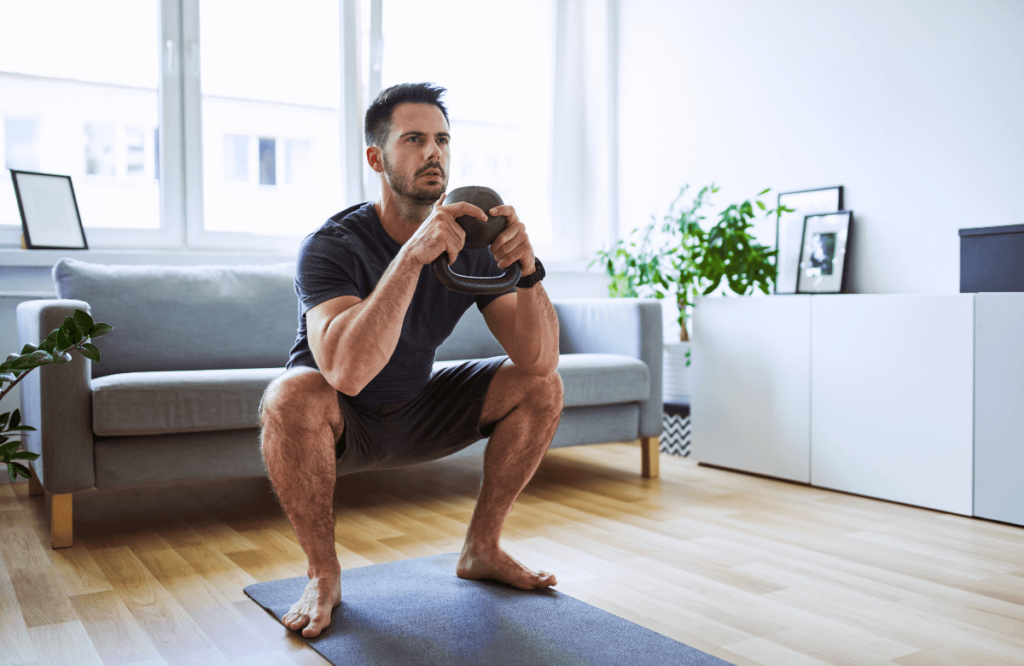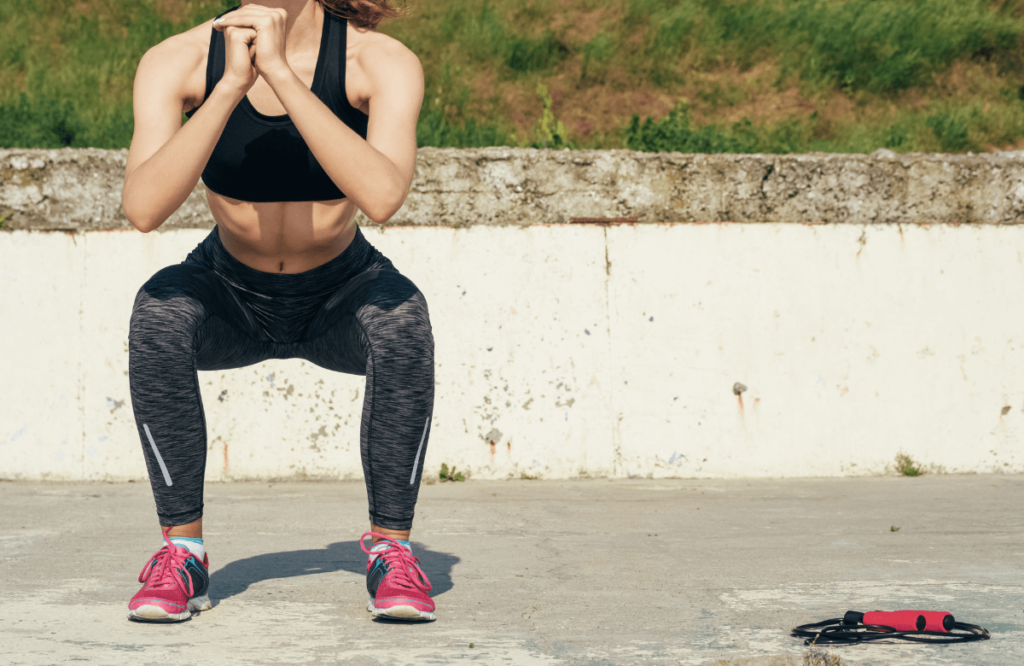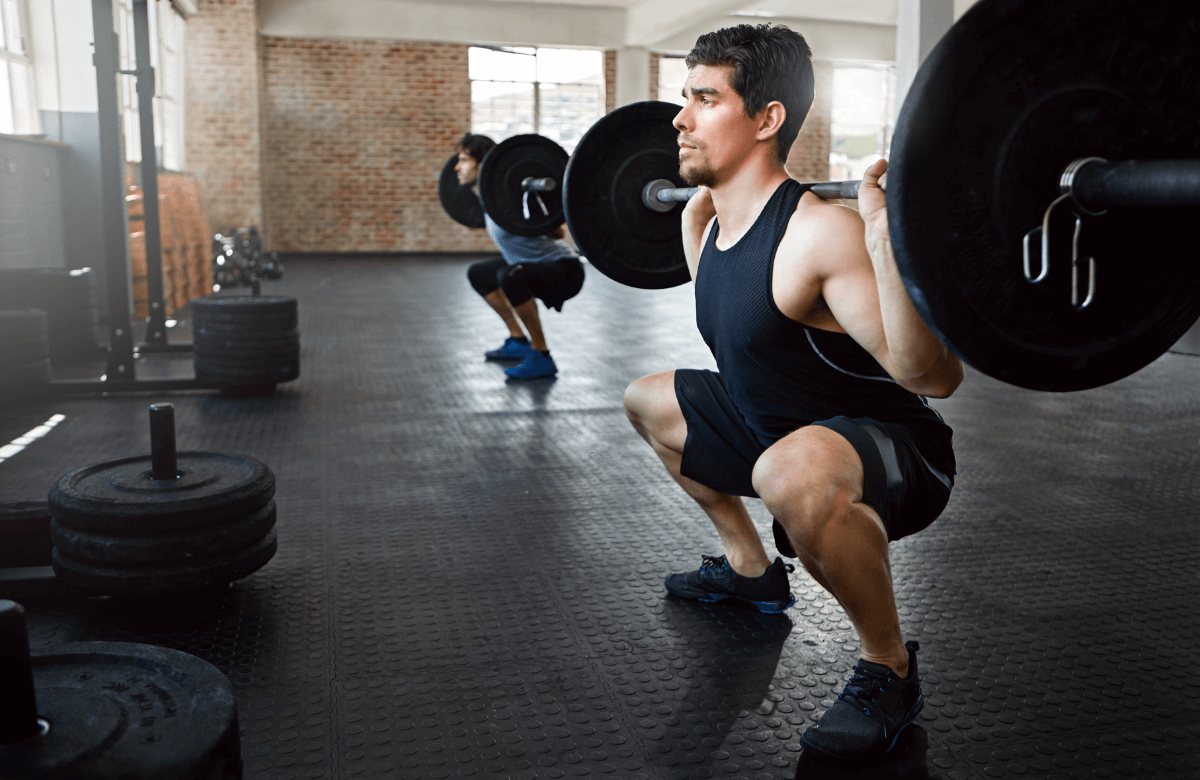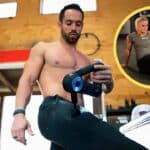One of the more common gym injuries people suffer from is knee pain when squatting. It’s not that squats are dangerous – far from it. They just have the potential to aggravate a vulnerable joint if they’re not done properly.
Before you write off squatting as dangerous, or rule it out as an exercise, read this article. It could help you to identify why you’re getting knee pain when squatting, then help you to remove it.
There are exercises in here that you can add to your workout routine. They’ll build your leg muscles, gluteal muscles and will improve your movement patterns. They can help make knee pain when squatting a thing of the past.
Done well, corrective exercises are a very effective treatment option for sore knees.

Jump to:
Seek advice and professional diagnosis
First of all, it’s important to start with some serious points…
Please don’t use anything in this article as medical advice. This isn’t a diagnostic article, it’s generic advice based on evidence and experience. It shouldn’t be confused with medical advice. If you’ve suffered a previous knee injury, only engage in physical activity when you’ve been cleared to do so.
If you haven’t had a diagnosis, make sure that before you do any of these exercises to cure your knee pain when squatting, have your injury assessed by a medical professional. Only train through pain if you’ve had a professional diagnosis and are cleared to do so.
The advice in this article can only be effective against problems that are mechanical in nature, and don’t stem from significant musculoskeletal injuries (such as tissue damage) or diseases such as knee arthritis. If you have a serious medical condition, always speak to your Doctor. Ask for recommendations about the best treatment options.
Knee pain when squatting – the usual suspects
There’s not one single stand out reason why people suffer from knee pain from squatting. What you tend to find is that it’s a combination of things. Usually poor technique, a lack of mobility, muscle imbalances and poor exercise selection.
We’ll address a few of the more common causes of pain, so you can rule them out as the cause…
Poor exercise selection
There’s no unified squatting technique – it’s an exercise that can be done in a number of different ways. Back squats, front squats, dumbbell squats, goblet squats, Spanish squats etc. The injury risk isn’t higher with any single one. It’s a case by case basis.
Your first approach should be to find out if it’s only one type of squat that causes you problems. For example, we know from research completed in 2022 that changing the squatting type can impact the forces that impact the knees and ankles. For some people, this will increase the risk of injury.
It might be that you can cope with Goblet squats, but not back squats for example.
Poor technique
Next up is technique. Whichever type of squat you perform, you have to execute great technique. This is vital if you want to avoid any form of knee pain. If there’s an underlying problem, bad form will expose it. Here’s a few tips around proper form when squatting…
- Make sure your weight is distributed across your feet (so you’re not only pushing through the balls of your feet for example)
- Engage the core muscles. They’ll stabilise the back.
- Work through a full range of motion
- Pick a weight you can cope with, without your form collapsing. You should be able to maintain a strong, upright torso throughout the lift
- Your knees should ‘track’ inline and over your toes. If you see your knees ‘collapse’ in, either drop the weight or change the exercise so you can strengthen the glutes.
By correcting your squat technique, you’ll reduce your chances of developing knee pain. You’ll also reduce the frequency of your bouts of knee pain.
IT Band Syndrome
One of the most common knee problems amongst exercisers is Iliotibial band syndrome (ITBS). It presents itself as pain down the lateral aspect (outside) of the knee joint and usually flares up during activity. Often running, squatting, cycling or sports requiring a lot of direction change.
It’s painful enough to stop people performing many of their favorite athletic activities. You’ll know if you have ITBS because it only affects the outer knee.
There are a number of causes of ITBS, but the three we most commonly see in the gym are…
- Weak hip and glute muscles
- Foot positioning during running/walking/exercise – usually over pronation due to technique or footwear
- Repetitive movements such as running – it often takes a while for ITBS to flare up, but kicks in when movement patterns are repeated
Evidence shows that these are both easy to correct with basic exercises. In their 2008 study, Beers et al saw progress in ITBS patients who adopted a strengthening and stretching approach to improving their condition.
This work built on previous conclusions by Fredericson in 2002 that showed that stretching could also be effective for helping to treat the condition.
Patellofemoral pain syndrome
Often referred to as ‘Runner’s Knee’, PFPS is a condition where the patient develops pain in the front of the knee, and around the patella (kneecap). Like ITBS, the problem usually only presents itself during activity.
There’s a lot of reasons why PFPS can occur, ranging from improper footwear for an activity, the knee cap being out of correct alignment, strength imbalance in the lower limbs, tight quad muscles etc.
Squatting can both be a causal factor, and used as part of a therapeutic approach. In research by Alba-Martin et al in 2015, various treatment approaches of PFPS were assessed. The study concluded that…
‘The intervention programs that were most effective in relieving pain and improving function in patellofemoral pain syndrome included stretching and strengthening exercises for the hip external rotator and abductor muscles and knee extensor muscles.’
This research helps to build the case that a lot of knee pain when squatting can be treated without serious medical intervention.

Lack of Ankle Flexibility
A lot of people won’t associate lack of ankle flexibility with knee discomfort, but the two are absolutely linked.
In a research study titled ‘The Association of Ankle Dorsiflexion Range of Motion With Hip and Knee Kinematics During the Lateral Step-down Test‘ published in the Journal of Orthopaedic & Sports Physical Therapy in 2016, researchers concluded that…
‘Individuals with lower ankle dorsiflexion range of movement exhibited hip and knee kinematics previously associated with several knee disorders”
What this means is that improving the range of movement at the ankle can have positive knock-on effects, potentially curing your knee pain when squatting. It’s also an easy way to remove one of the major risk factors of other types of knee joint pain.
Exercises to help knee pain
Now that we’ve established that some of the common reasons for knee pain when squatting are fixable, we have to look at the solutions…
These exercises all have therapeutic benefits. They’ll strengthen muscles associated with knee pain when squatting, so you’ll be ready and able to work your way to pain free movement.
Lateral band walks
This is a go-to exercise for me and my personal training clients. They help to strengthen the glutes and hips, which has a knock-on effect of helping to stabilize the knees.
It’s a tough exercise when performed properly, but it’s fantastic. All you need is an elastic resistance band. I also use it as a preventative exercise. It helps to stop problems forming in the first place!
Spanish squats
If I could suggest one single exercise to help prevent/fix knee pain when squatting, it’d be the Spanish squat.
It’s a simple exercise, but the effects are fantastic. The support of the elastic band helps you to hit deep squats every time. Not only does it help to isolate the quads better than any other squat that I’m aware of, it has helped a lot of people I know to fix their knees.
Step ups
I like step ups because they offer a number of benefits to the lower limbs. Many people can’t achieve a great squat depth, but they can hit a full range of movement with step ups.
I use these in place of squats for those who can’t get ass to grass. They train a single leg at a time. They also activate the hips and glutes, which helps to fix knee pain when squatting.
Walking lunges
Like step ups, walking lunges are a single leg exercise that involve the glutes and hips too. Of course they hit the quads, but the dynamic nature of them means there’s a lot of stability involved. This helps to improve both leg strength and knee health.
Preventing Knee Pain in Future
So we have a list of exercises to help treat (and prevent) knee pain when squatting, but here are some practical tips to help you prevent the problem coming back…
Working through a full range of motion
Your range of movement is important when it comes to knee health. If you perform leg exercises such as squats, lunges, step ups etc, hit at least parallel depth. This is where your quads are parallel to the floor.
Working through a full range of movement engages all of the target muscles of the exercise.
If you struggle with this depth, try the following…
1. Lift a lighter weight, so you can improve confidence.
2. Use a wedge to help increase range of movement.
3. Wear weight lifting shoes when squatting to help hit depth.
4. Change your foot placement – make them a touch wider, and turned out a few degrees.
A full range of movement also helps to maintain mobility. This is important for joint health, injury prevention and connective tissue flexibility.
Make sure form is excellent
Correct form when exercising isn’t a vanity point. It’s there to make sure an exercise is performed well. When you use good form, you engage all of the muscles as they should be engaged. When you work through a full range of motion, you make sure everything fires as it should.
This helps to prevent muscle imbalances, overuse by certain muscles and make exercises more effective. When you exercise with correct technique, you’ll often find that chronic knee pain disappears.

Strengthen your abdominal muscles
Abdominal strength is important in all forms of weight training, as well as helping to prevent risk in everyday activities. Your core strength is fundamental to good exercise technique and balance. When this is off, there’s a greater risk of injury through exercise.
By strengthening your core, you don’t remove all risk, but you help to reduce it. You’ll also help to improve your body posture and your form when performing a range of exercises in a fitness routine.
Ensure you wear correct footwear
Footwear is an often overlooked aspect of training. Running shoes aren’t ideal for weight training. They’re too soft underfoot, they aren’t stiff enough on the upper (meaning they lack support) and the sole isn’t flat.
By wearing appropriate footwear for training, you ensure you are stable from the ground up. This creates a stable platform all of the way up the chain. Ideal footwear includes… weightlifting shoes, and hybrid shoes such as Nike Metcons and Reebok Nanos.
You can also squat barefoot – it has been shown to be helpful for knee pain and form. Just be careful where you do it!
Use the advice contained in this article to help remove your knee pain. You can add these exercises into your daily routine, and in a short period of time (4-8 weeks) you’ll build up the muscle strength to solve a lot of common knee conditions.
Strong legs are healthy legs. The tips here will help you to enjoy pain-free squatting for life. You’ll also remove the need for a more invasive form of treatment.















